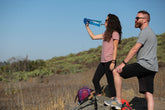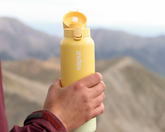There are few things as energy-intensive as exploring the great outdoors. Whether you’re hiking, biking, kayaking, or camping, you need to keep your energy levels high to stay safe and enjoy the experience.
However, most approaches to outdoor energy are a little outdated. Adventurers like John Muir might have explored the Sierra Nevada mountains with little more than a handful of nuts and some tea, but that doesn’t mean that a minimalist approach is necessarily optimal.
Instead, you need to find ways to stay energized during outdoor adventures that work for you. Ideally, you should take a holistic approach to energy that accounts for your sleep quality, hydration, and nutrition. This will help you stay focused while building a bivouac or rappelling down a rock face.
Sleep
The preparation for an outdoor adventure starts long before you step foot on a trailhead or set an anchor. You have to check your equipment, map your route, and create backup plans in case of emergency — you also need a good night’s sleep to ensure that you stay energized and focused during your time outside.
Sleep is an integral part of your energy. Insufficient sleep is associated with long-term illnesses like obesity and cardiovascular disease, and even missing a single night's sleep can wreak havoc on your body’s ability to regulate energy expenditure. Additionally, sleep loss puts you at greater risk of accidents, as research shows that a lack of sleep induces “impairments in cognitive performance equivalent to alcohol intoxication”.
Pay particular attention to your sleep schedule for the week leading up to your outdoor adventure — a single night of heavy sleep can’t undo an entire week of burning the midnight oil. The CDC recommends 7-9 hours of sleep for adults, but it’s best to err on the side of oversleeping slightly to improve your focus and energy levels during your outdoor excursions.
Nutrition
The food you eat plays a massive role in regulating everything from emotions to energy levels. Common sense should tell you that sugary, carb-dense foods like cookies or chips aren’t usually the best fuel for any activity — including outdoor adventures that require more energy than you are used to.
As a general rule, it’s better to stick to energy-dense whole foods while doing activities like mountain biking or hiking. Things like nuts, raisins, and bananas are ideal for a small snack as they don’t take up much room and have a relatively high caloric density.
However, snacks alone aren’t enough to make it through a full day of adventuring. Activities like rock climbing can burn around 700 calories per hour, which will leave you at risk of a dangerous caloric deficit and nutritional deficiency. So, at mealtimes, try to make dishes that are calorically dense and high in protein for recovery.
Your body’s ability to digest certain foods will impact your energy levels. This is particularly important if you have a food intolerance, or find yourself feeling bloated or chronically fatigued. Low energy is a sign of food sensitivity, so it’s worth staying away from ultra-refined foods like bread and processed meats while adventuring in the great outdoors.
Hydration
We’ve all experienced the light-headedness that comes with dehydration, yet you probably still don’t have a clear hydration plan when exploring outdoors. This is a serious misstep, as water is vital for your overall health and energy. Water helps to regulate your body temperature, protects your joints, and helps you absorb the nutrients you need when completing strenuous activities like enjoying the outdoors.
You should create a hydration plan during outdoor adventures to avoid dehydration and stay energized. For example, you can stay hydrated while hiking by drinking two glasses of water before you tie up your boots, then drinking “little but often” during your hike. This might mean that you drink 100ml every time you pass a mile marker, or simply take a swig every time you have a short rest.
If you don’t enjoy the taste of water, consider adding frozen fruits to your bottle or mixing a sports drink into your H2O. Sports drinks usually have a strong flavor and contain carbohydrates that may help with intra-exercise nutrition. By themselves, they might contain too much sugar and cause a headrush, but they’re still effective when mixed with water.
Energy Boosts in a Pinch
Sometimes things go awry while you're adventuring outdoors. Even if you’ve eaten well, had a good night's sleep, and are well hydrated, you may still suffer from a sudden dip in energy. If this occurs, take stock of your surroundings and ask yourself why you might be feeling lightheaded. Chances are, you’ve probably overworked yourself or are suffering from a form of heatstroke.
If you’re in a safe, shaded space, consider taking a quick nap for an energy boost. Just ensure that you don’t nap for more than 15-20 minutes or you risk falling into a deep sleep and feeling even more groggy when you wake up. Done right, a quick nap can help you recover from fatigue, and may improve your focus and memory retention. A well-earned nap can also bring down your stress, and make it easier to relax after the adrenaline of an adventure in the great outdoors.
Conclusion
Staying energized while outdoors is about more than swigging coffee and eating sugary foods. You can improve your overall energy levels and get more from your adventures by getting a good night’s sleep before you set off, staying well hydrated throughout the day, and by eating plenty of energy-dense whole foods to fuel your activities.



